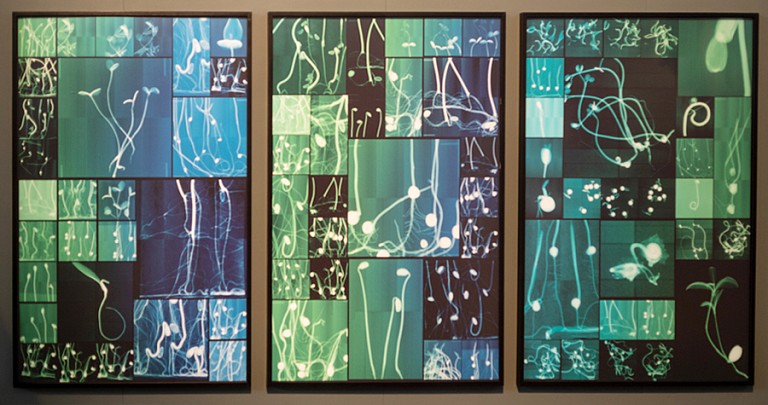
REVIEW: Dornith Doherty at the Impressions Gallery, Bradford, UK
November 4, 2020 - Giovanna L. Costantini for Leonardo
The artwork, in the words of the writer Julio Cortázar, “is like the seed in which the giant tree lies sleeping.” From sunflower to rosehip, there may be no more metonymic sign for art than the seed, an embryonic kernel whose formation is part of vegetal reproduction that generates sustenance for life. Plants, the fruition of the seed, share with photography a light-driven process of development corresponding to photosynthesis. Imperiled by environmental circumstances, a photographic exhibition, “Seedscapes: Future-Proofing Nature” currently on display at the Impressions Gallery in Bradford, England, examines the response of artists to global conditions that threaten seed viability and the survival of ecosystems that allow all forms of life to prosper.
Conjoining multiple disciplines that include botany and paleobotany, biology, evolutionary biology, geology and socio-ecology with an array of technologies ranging from digital microscopy to satellite imaging five artists explore integral relationships between humankind and its environment through scientific analysis and the poetic correspondence that exists between art and the natural world. While their works celebrate incipience and survival, they also confront the reality of ecological damage as they participate in strategies of remediation.
Several artists in the exhibition appropriated seeds stored in research facilities, vaults and seed banks established to ensure the survival of genetic material and agricultural species. Dornith Doherty’s “Seedling Cabinets” conveys the intricate vigor of life’s embryonic beginnings through digital chromogenic lenticular collages made from magnified x-rays of tiny plantlets and seeds (some the size of a grain of sand) captured from the National Center for Genetic Resources Preservation (USA) and the Millennium Seed Bank (England). By utilizing on-site x-ray equipment routinely used for viability assessments of accessioned seeds, Doherty draws attention to complex issues surrounding the role of science and human agency in relation to gene banking. Arranged in asymmetrical grids the seedlings form curvilinear patterns that appear written in light, akin to the automatic writing of Surrealists. Charged with energy, they spring from frame to frame, animated, at times balletic, their graceful sinuosity an attribute of life drawing and of design. Suffused with the color indigo the collages evoke a celestial dimension, transcendent, a union of microcosm and macrocosm.
Crystel Lebas’ Field Studies interrogates evolutionary time and environmental demise by revisiting the landscapes photographed during the 1920’s and 1930’s by Sir Edward James Salisbury, the pioneering ecologist and author of The Living Garden (1935) who once served as director of the Royal Botanic Gardens at Kew. Working in collaboration with The Natural History Museum in London, Lebas utilized a collection of glass plate landscape photographs and field notes taken by the botanist in the British Isles in order to return to the same locations almost a century later to document changes in landscape environments and their inhabitant plants. Employing GPS coordinates she retraced Salisbury’s steps throughout England and Scotland, gathered information from relevant scientists, botanical sources and topographic evidence and re-photographed locations to document changes wrought by climate and human enterprise. By juxtaposing gelatin silver prints from Salisbury’s original glass plate negatives with panoramic chromogenic vistas taken by the artist, the apposition of archaic and contemporary technologies, optical with exaggerated scales, and faded transparency with darkened views at dusk, Lebas questions humankind’s relationship to the natural world and laments the loss of fecund wilderness. Accompanied by maps meticulously imprinted with numeric coordinates, viewers are oriented to the imagery by way of precise navigational systems and calculated measurements utilized in locating the sites exhibited.
Sant Khalsa’s “Trees and Seedlings” also employs gelatin silver transparencies in combination with poplar wood planks in a sculptural installation that accentuates perishability, industrial utility and the depletion of natural resources. Responding to forest fires and its effects of deforestation in California, her negative projections of trees burnt in forest fires imprinted on glass are inserted into finished lengths of lumber, propped against the wall as planks of timber to be sold in stockyards. The light emitting transparency of these images, cut to size and narrowly fitted within lengths of sawn boards contrasts fragility with durability in ways that sever nature’s capacity for growth and renewal from the built environment. As an extension of this trajectory in an ongoing practice of reforestation, since 1992 Khalsa has planted over 1000 ponderosa pine seedlings in valleys of the Southern California mountains documented in a documentary “Growing Air” displayed in the gallery.
Fragility and preservation also inspired Liz Orton’s stunning photographs of plant specimens from around the world housed in the Kew Gardens Herbarium, a collection of dried plant specimens that dates as far back as 1840. “Splitters and Lumpers” exhibits photographs of perishable plant samples as they await sorting, classification and storage. The specimens’ organic nature is mirrored in their physical movement towards the edges of paper sheaths where cross-section views render the specimens as stratified mille-feuilles of culture and nature. The budding fruitfulness of the specimens appears to challenge their compression and confinement within deteriorating folio pages as Orton’s high-resolution photographs assert the plants’ vitality, pushing against the limits of the frame. By interrogating the knowledge systems that herbaria represent, Orton aligns herself with botanists such as Linnaeus whose Systema Naturae of 1735 established systems of taxonomy that classify an ever-changing, evolutionary world. Yet her photographs also point up art’s eloquent subjectivity, together with nature’s resolute transgressions that often blur taxonomic categories and resist its restrictive boundaries.
Heidi Morstang’s “Prosperous Mountain” a film that presents an evocative visual journey to the Svalbard Global Seed Vault in the Arctic archipelago of Svalbard, Norway explores the specific global landscape of the Arctic as a delicate eco-system. The Svalbard Global Seed Vault, a gene bank constructed deep inside a mountain on a remote island midway between Norway and the North Pole is located as far north as a person can fly on a scheduled flight. It conserves the largest collection of unique crop genetic material acquired throughout the world in a long-term storage facility built to withstand the challenge of natural or man-made disasters. Permafrost and thick rock enclosure ensure that the more than one million seed samples will remain frozen in perpetuity, sealed inside boxes and stored on shelves within a vault maintained at -18C. As the ultimate insurance policy for the earth’s food supply, the vault secures for future generations every known species of crop variety available in the world today.
Morstang’s installation consists of a photographic exhibition combined with documentary footage. “Ringhornalen,” presents electron micrographs depicting seeds found in one of the islands sliced to expose their interiors in ways that resemble other-worldly topographies. An experimental documentary, “Prosperous Mountain,” visualizes the artist’s experience of the Svalbard environment. Each exhibit complements the other symbiotically through correspondences between microscopic and macroscopic visuals, still and moving images, envelopment in darkness and light at extreme poles of the photographic value scale. These qualities impart exquisite symmetry to an ensemble that is as ephemeral as it is enduring, through which the whole of creation may be perceived in the infinitesimal landscape of a tiny seed.
“Prosperous Mountain” chronicles incidents of human intrusion––jet airplanes, semi-trailers, snowmobiles, refineries, conveyer belts, storage facilities—upon a virtual tundra as pristine and elemental as it is despoiled by manmade forces. Sounds of howling winds and crackling ice are pierced by the deafening roar of F17s that rip the sky at combat speed; loads of carbon dump onto fossil deposits, their black dust dispersed into the air; white-out snow squalls and rolling waves are intercut with smokestacks, transmission towers and engines. Scenography is impressionistic in its atmospheric effects of ice-dappled seas and floating mists, with masterful spatial effects that alternate between the even stability of an unbroken horizon traversed by a solitary ship, and the deep, disquieting void of a concrete tunnel that recedes into the distance as a haunting burial chamber. In its entirety, the film constitutes a poetry of place and of being.
In an era of climate change and declining biodiversity, “What Can Art Do?” asks Curator Liz Wells in an essay that accompanies the exhibition. Conceived as a contribution to contemporary environmental concerns exacerbated by extreme global warming and its catastrophic effects upon society, Wells approached the exhibition as an opportunity to integrate ecology, politics and aesthetics. Seeking to elevate public awareness and make visible through applied new technologies what would normally not be perceived by the human eye, the exhibition aims to engage viewers in investigative ways of seeing so as to promote contemplation and societal engagement. These intentions reflect other artistic interventions for which climate change has become a major subject for artists throughout the world, including such luminaries as Olafur Eliasson, Agnes Denes, Joan Jonas and Ai Weiwei, their exhibitions intent on breaking through into public consciousness. Amid myriad “Anthropocene” exhibition titles, the reality of climate change remains an historical condition that inspires much of contemporary art today.
Yet environmental aesthetics have informed both the marriage of art and science as well as the relationship between art and nature since antiquity. Stemming from the principle of cosmic harmony inherited from the Pythagorean tradition, the universe is considered bound by a single rule that is at once scientific and aesthetic, manifest in a music of the spheres inaudible to the human senses. Newer paradigms of aesthetic sensibility hold that an aesthetic experience of the natural world is as emotionally and cognitively rich as that of art, whether its stimulus originates in the world or in the mind and heart of an individual. That which is critical in each encounter is an appreciation guided by understanding, a goal consistent with the aims of Seedscapes through its multisensory channels enabled by advanced technology. Through such media, artists strive to achieve a heightened affective response on the part of the viewer, one that promotes ineffable feeling and an aesthetic appreciation of nature possessed of integrational qualities engendered by science. The connective membrane between a sensory appreciation of natural environments and the cognitive grasp of scientific knowledge of organic life occupies a central position in environmental aesthetics, one that informs the imagination, knowledge of the human condition and humankind’s place in the cosmos.
It was the idealist philosopher Hegel who wrote that “…the torch thistle, which blooms for only one night, withers in the wilds of the southern forests without having been admired, and these forests, jungles themselves of the most beautiful and unenjoyed. But the work of art is not so naively self-centered; it is essentially a question, an address to the responsive breast, a call to the mind and spirit.”
“Seedscapes: Future-proofing Nature” is an Impressions Gallery touring exhibition curated by Liz Wells in association with the Dick Institute and Royal Albert Memorial Museum & Art Gallery. It is at Impressions Gallery, Bradford, until December 12 2020, then on tour at Royal Albert Memorial Museum & Art Gallery, Exeter from 6 February to 2 May 2021 and at the Dick Institute, Kilmarnock. Scotland in Autumn 2021. Accompanied by extensive online documentation, artist statements and other resources, an immersive 3D virtual platform produced in cooperation with V21 Artspace and Pippa Oldfield of Impressions Gallery may be viewed at www.impressions-gallery.com.
Download Article (PDF)
Back to News
